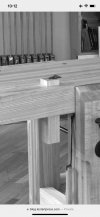Amateur woodworker here building my first workbench. I’m following the anarchist workbench book/plan given how prescriptive it is (helpful for a first timer).
However, for someone that has been planing board faces only occasionally its not obvious a 2 1/2” x 2 1/2” square hole in the bench for a removable planing stop (1st picture) will be more useful than a simple setup attached at the end of the bench (2nd picture).
Are there non-obvious benefits to being able to pop it in and out that become more useful as your project/skills advance?
All input is appreciated!
P.S. Found this forum last year and it’s just a wonderful resource and community.
Joe
However, for someone that has been planing board faces only occasionally its not obvious a 2 1/2” x 2 1/2” square hole in the bench for a removable planing stop (1st picture) will be more useful than a simple setup attached at the end of the bench (2nd picture).
Are there non-obvious benefits to being able to pop it in and out that become more useful as your project/skills advance?
All input is appreciated!
P.S. Found this forum last year and it’s just a wonderful resource and community.
Joe



